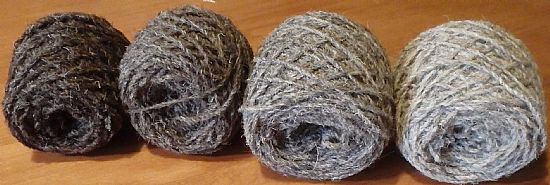Why knit?
Someone we know works with Herdwick meat. His company introduced a new (grown-up) policy of collars-and-ties in the office. Clearly he needed a Herdwick tie, not some feeble pale lemon silky job.
So the search began.... and although extensive, turned up nothing. Indeed, those excellent people at the Wool Clip in Caldbeck said they had been trying for months to find Herdwick ties, and had completely failed.
So nothing for it but to start work ourselves. We have always had a penchant for the knitted style, a delightfully retro-look which seems to suit a back-to-the-country, let's-feel-good-about-natural-things ethic, so this was the obvious way to go.
Add to that some glorious Herdwick rug wool by Christine Crofts (rug-maker extraordinaire) which is crisp and hairy, immensely tactile, and deeply evocative of the Herdwick breed, and something seems to come alive in your hands. 
Obviously the natural Herdwick shades are the best, spangled as they are with guard hairs and in a variety of unique shades - no two hanks of wool are the same. As you undoubtedly know, the lambs start off very dark brown and gradually mature through intermediate shades of grey to an almost silver-white on the elders of the flock. What a splendid palette!

But temptation looms: Chris Crofts hand-dyes natural Herdwick wool for her rugs and some of her colours are simply glorious. Can't be overlooked - but these are for fun. Your FIRST tie has to be one of the natural shades.
A suitable pattern was found after more extensive research: we ended up with one which seemed to have one or two unique features. A few experiments with Christine's wool (and another, more mainstream Herdwick product) led to some modification of the design. The original pattern knitted up to something more akin to a winter scarf - Herdwick wool is not exactly fine - but a few experiments later and a reasonable tie has emerged. It needs to be substantial to show off the glory of the wool, but it also needs to be wearable.
The finished model works well with a simple Westmorland Knot (click the link for instructions). This is based on the Oriental Knot, and is pretty straightforward when you get the hang of it.
Here we go....

